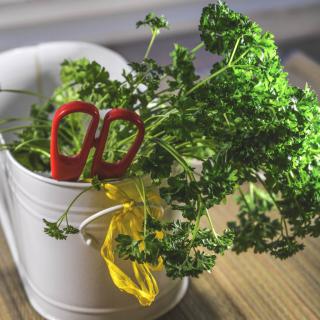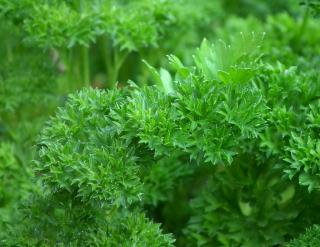

Parsley is a commonly used spice that grows easily.
Parsley key facts:
Name – Petroselinum crispum
Family – Apiaceae (parsley family)
Height – 10 to 12 inches (25 to 30 cm)
Exposure – full sun, part sun
Soil – rich and light
Harvest – all year round
From planting or preparing seedlings all the way to the harvest, here is how to care for parsley.
Generally speaking, sowing parsley outdoors is considered possible as soon as February in the South and March in the North.
If you purchase your parsley in pots, plan to re-pot it quickly in a larger pot or transplant it directly in the ground after buying.
Parsley can be sown directly in the soil at the end of winter, during spring and summer.
If you fear that deep frost spells might occur, it is best to protect your seedlings with a cold frame, a tunnel greenhouse or horticultural fleece.
As soon as the plants have formed 4 or 5 leaves, thin to about 4 inches (10 cm) to give the seedlings space to grow.
 Leaves can be cut as needs arise all year long.
Leaves can be cut as needs arise all year long.
It is best to collect leaves one at a time, instead of tearing out a whole bunch or cutting several stems at once with scissors.
You can collect parsley in all seasons, but it is important to protect your parsley in winter, with a garden cloche for instance, or moving it to an unheated greenhouse.
Favor eating older leaves first.
Parsley is a biennial plant that grows 10 to 24 inches (25 to 60 cm) tall, very fragrant when leaves are rustled.
Curly parsley and flat-leaved parsley is mostly used to flavor mixed salads, omelets or dishes with gravy. When cooking with parsley, use also parsley stems, their taste is more intense than leaves are (especially for curly parsley).
 Shredded parsley makes for great persillade, to season seafood and barbecues.
Shredded parsley makes for great persillade, to season seafood and barbecues.
They are easy to grow and resist most diseases well.
A good chef certainly prefers flat-leaved parsley for its more delicate taste.
Parsley contains high amounts of essential oil of which a major portion is apiol, a substance that is very common in fruits, as well as vitamins A and C.
Over winter, cover your parsley with a clear garden cloche to keep harvesting until the following spring.